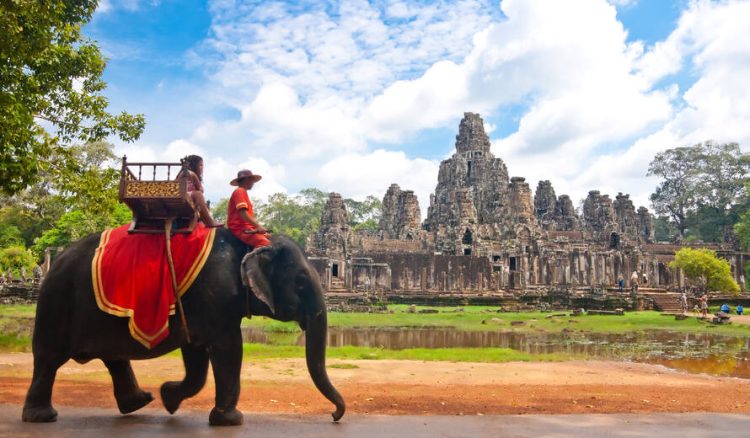Introduction: The Magic of Connecting Nature and Culture
Traveling offers more than just a change of scenery; it’s a chance to discover the world through the eyes of its local people. For nature lovers, immersing oneself in scenic spots can be a deeply fulfilling experience. But what makes this experience even more meaningful is the opportunity to understand the connection between these natural wonders and the cultures that revere and protect them. Sacred mountains, pristine lakes, national parks, and natural landmarks are not only visually stunning but often carry deep cultural significance. In many places, nature is intertwined with local customs, traditions, and spiritual beliefs.
This guide explores how you can discover nature’s beauty while respecting and understanding the local cultural context. Whether you’re hiking through majestic mountains, visiting national parks, or exploring sacred natural sites, there’s a unique way to experience nature in every corner of the globe. By learning the cultural significance of these locations, you can gain a richer, more respectful experience of the natural world and the communities that call it home. Here are the best ways to experience nature while traveling and tips for exploring scenic spots that align with local customs.
How to Discover Scenic Natural Spots That Are Culturally Significant
When traveling, we often seek out the most breathtaking landscapes, but these places hold deeper meanings in many cultures. Some natural spots are considered sacred, while others are historically important to the communities that live near them. To truly appreciate the connection between nature and culture, it’s essential to go beyond the typical tourist view of these landscapes and look for their significance to local traditions.
- Research the Cultural Importance of Natural Landmarks: Before heading to your chosen destination, take the time to learn about the local culture and history. Many natural wonders, like rivers, mountains, and forests, are not only beautiful but are also woven into the region’s spiritual practices, creation myths, and traditions. For instance, Mount Fuji in Japan is not just a stunning peak but is also a site of spiritual pilgrimage and cultural reverence. Similarly, sacred lakes like Lake Titicaca in Bolivia hold deep cultural significance for the indigenous Aymara and Quechua people.
- Look for Cultural Festivals That Celebrate Nature: Many communities hold festivals that honor the connection between people and nature. These festivals might revolve around the harvest, the changing of seasons, or specific natural phenomena. For example, the annual Cherry Blossom Festival in Japan celebrates the beauty of nature and the impermanence of life, while the Peruvian Inti Raymi festival honors the sun and nature’s cycles. By participating in these events, you gain insight into how local cultures interact with their natural environment.
- Visit UNESCO World Heritage Sites: UNESCO has recognized certain natural sites for their outstanding cultural and natural value. These locations, such as the Great Barrier Reef in Australia, Yellowstone National Park in the U.S., or the Galápagos Islands in Ecuador, are not only visually stunning but also hold cultural and ecological significance. Visiting these sites gives you a deeper understanding of the delicate balance between preserving nature and respecting the cultures that depend on these ecosystems.
- Seek Local Guides for Deeper Insights: When you visit a natural landmark, consider hiring a local guide. Locals are often the best storytellers and can offer a wealth of knowledge about the significance of the place, its cultural importance, and the sustainable practices that help preserve it. Guided tours can offer you a more respectful and meaningful way to experience nature.
The Importance of Respecting Nature-Based Customs During Your Travels
While exploring scenic nature spots is an exciting part of traveling, it’s crucial to approach these experiences with a sense of respect. Many communities have long-held customs related to nature conservation, sacred sites, and eco-tourism. Understanding and respecting these traditions not only deepens your connection with nature but also ensures that you are traveling responsibly and sustainably.
- Respect Local Spiritual Practices: Many natural sites hold spiritual significance to indigenous communities. For example, the Uluru rock formation in Australia is a sacred site for the Anangu people, and climbing the rock is considered disrespectful. Similarly, visiting sacred groves in India or temples built near mountains requires appropriate behavior, including dressing modestly, avoiding loud noise, and asking for permission before taking photographs. Understanding these cultural practices helps ensure that your visit doesn’t cause harm or offense.
- Practice Leave No Trace Principles: One of the most important aspects of respecting nature during your travels is adhering to the Leave No Trace principles. These principles encourage visitors to minimize their impact on the environment. This means avoiding littering, sticking to marked trails, and being mindful of wildlife. By respecting these practices, you help preserve the natural beauty of the area for future generations while also respecting the local community’s relationship with the land.
- Support Sustainable and Eco-Friendly Tourism: In many regions, eco-tourism plays a vital role in protecting the natural environment while also supporting local communities. By choosing eco-friendly accommodations, supporting conservation initiatives, and participating in responsible tours, you can help ensure that your travel benefits both the environment and the local people. Many national parks and protected areas have eco-tourism programs that focus on preserving local traditions while promoting sustainable practices.
- Engage in Responsible Wildlife Viewing: Wildlife is a key aspect of many natural landscapes, but it’s important to approach wildlife encounters with respect. Avoid disturbing animals in their natural habitat, do not feed them, and always follow local guidelines. Many countries have strict wildlife protection laws that help preserve endangered species and their habitats, so it’s essential to adhere to these rules.

Best Destinations for Nature Lovers: National Parks, Sacred Sites
The world is full of breathtaking natural destinations that offer the perfect balance between stunning landscapes and rich cultural heritage. These places are not only beautiful but also carry deep significance for the local populations. Here are some of the best destinations for nature lovers seeking to explore nature in harmony with local customs:
- Yellowstone National Park, USA: Known for its geothermal features, wildlife, and natural beauty, Yellowstone is a UNESCO World Heritage site and one of the world’s first national parks. It is also home to Native American cultural sites, and many indigenous groups, including the Shoshone and Crow, consider the land sacred. Exploring the park with respect to its cultural and natural importance is essential.
- Sacred Mountains of China (Mount Tai, Mount Huangshan): China’s sacred mountains, such as Mount Tai and Mount Huangshan, are not only dramatic landscapes but also important spiritual sites. Mount Tai, in particular, has been a pilgrimage site for over 3,000 years. Visitors are expected to approach these mountains with reverence, as they are considered the residence of deities in Chinese mythology.
- The Galápagos Islands, Ecuador: A paradise for nature lovers, the Galápagos Islands are home to unique wildlife and dramatic landscapes. The islands also hold cultural significance for the indigenous peoples of Ecuador. Visitors must follow strict eco-tourism guidelines to help preserve the delicate ecosystem and ensure the protection of local traditions.
- Uluru-Kata Tjuta National Park, Australia: Uluru is one of the most iconic natural landmarks in the world, and it is also a sacred site for the Anangu people. Visitors are asked to respect the site by not climbing Uluru and by learning about the cultural practices associated with the land through guided tours led by indigenous people.
- Bavarian Forest National Park, Germany: As Germany’s first national park, the Bavarian Forest is a stunning natural destination that celebrates local conservation practices and wildlife protection. The region also has a deep connection to traditional German folk customs, which often emphasize the importance of nature and sustainability.
Tips for Exploring Nature in Harmony with Local Traditions
To experience nature in the most meaningful and respectful way, here are some travel tips that can help you stay in harmony with local customs:
- Do Your Research: Before visiting a natural site, research the area’s cultural significance. Learn about local beliefs, sacred sites, and customs that might affect how you experience the landscape.
- Be Mindful of Your Presence: Whether you’re hiking, taking photos, or simply enjoying the view, always be aware of your impact on the environment. Stay on designated paths, respect wildlife, and avoid loud or disruptive behavior.
- Follow Local Guidelines: Many natural sites have specific rules in place to protect both visitors and the environment. Be sure to follow these rules, including respecting opening hours, no-photography zones, or restricted areas.
- Engage in Community-Based Tourism: Choose local tours that involve local guides and communities. This not only enhances your travel experience but also helps ensure that the benefits of tourism go directly to the people who live in these areas.
Stories from Travelers Who Found the Perfect Balance Between Nature and Culture
Many travelers have successfully explored nature while respecting local customs and traditions. Here are a few examples:
- Exploring Patagonia’s National Parks: “I traveled through Patagonia and visited the Torres del Paine National Park in Chile. I hired a local guide who explained the significance of the land to the indigenous Mapuche people. By staying in eco-lodges and respecting the environment, I was able to fully appreciate the natural beauty without harming the delicate ecosystem.”
- Visiting Mount Fuji, Japan: “Climbing Mount Fuji was an incredible experience, but what made it special was learning about the spiritual connection the Japanese people have with the mountain. I made sure to respect the cultural customs, such as offering prayers at the shrines along the route, and I took time to reflect on the significance of the mountain.”
- Exploring Sacred Sites in Bali, Indonesia: “During my trip to Bali, I visited temples surrounded by lush landscapes. I made sure to dress appropriately, cover my shoulders, and follow the local customs by participating in a traditional Balinese blessing ceremony. It was a unique experience to see how nature and spirituality are so deeply intertwined in Balinese culture.”
Conclusion: Experiencing Nature with Respect and Awareness
Experiencing nature is one of the most enriching aspects of travel. Whether you are exploring mountains, national parks, or sacred sites, it is essential to approach these landscapes with respect for both the environment and the local culture. By taking the time to understand the cultural significance of natural sites and following responsible travel practices, you can ensure that your travels contribute positively to both the places you visit and the communities that call these places home. Through mindful exploration, you will gain a deeper connection with nature and the people who protect it.





















